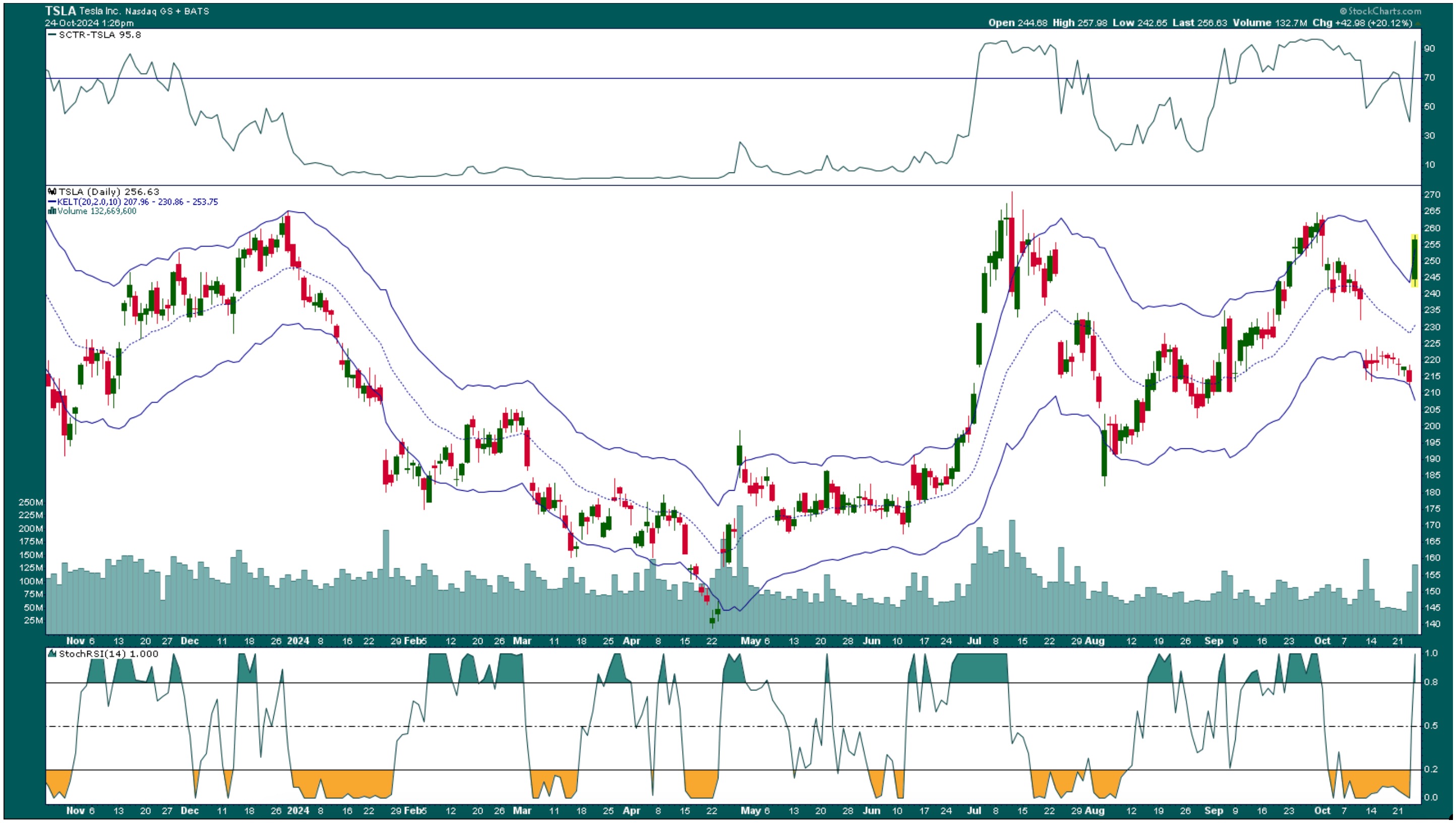KEY
TAKEAWAYS
- TSLA stock soared on upbeat Q3 earnings report.
- TSLA’s stock price has broken above the upper Keltner Channel, indicating strength and the early stages of an uptrend.
- Adding a momentum indicator like the StochRSI to Tesla’s stock analysis can help make smart trading decisions.
Tesla (TSLA) reported better-than-expected earnings after the close on Wednesday. This sent the stock price soaring, which was enough to put TSLA stock in the lead in the Large Cap Top Up StockCharts Technical Rank (SCTR) Report category. It was also the most actively traded S&P 500 ($SPX) stock.
FIGURE 1. SCTR REPORT FOR LARGE CAP TO UP CATEGORY ON OCTOBER 24. TSLA stock reached the top of the category after reporting better-than-expected earnings.Image source: StockCharts.com. For educational purposes.
Tesla Stock Analysis
TSLA’s stock price has struggled since November 2021. After hitting a low in January 2023, TSLA stock has been choppy—rising till July 2023, then pulling back, climbing, pulling back, climbing, and falling on the unimpressive Robotaxi day (see weekly chart of TSLA below).

FIGURE 2. WEEKLY CHART OF TSLA STOCK. The stock price is close to its previous weekly high. A move above that high would support an uptrend in the TSLA’s stock price.Chart source: StockCharts.com. For educational purposes.
After the strong Q3 earnings report, the stock is climbing again. Will it bust through its previous high to continue its uptrend?
TSLA’s stock price on the daily chart is much more erratic than the weekly chart, with many up-and-down price gaps.

FIGURE 3. DAILY CHART OF TSLA STOCK. The stock broke above the upper Keltner Channel, the SCTR score spiked, and the StochRSI indicator jumped from oversold to overbought territory. Could this be the beginning of an uptrend?Chart source: StockCharts.com. For educational purposes.
The recent earnings report shows a massive breakaway gap up in price. The SCTR score spiked from around 41 to over 90. TSLA’s stock price has also moved above its upper Keltner Channel, which has started to turn upward. This indicates significant strength in the stock and the beginning of an uptrend.
One day doesn’t make a trend, so using a momentum oscillator such as the StochRSI when using Keltner Channels can help determine whether the uptrend will continue. The spike in TSLA’s stock price caused the StochRSI to jump from oversold to overbought territory in one day—in this case, it went from 0 to 1, which is unusual.
Trading TSLA Stock
A significant jump in a popular stock such as TSLA will tempt investors to get in on the price action. But as a smart investor, do you follow the crowd or wait for a pullback before jumping in? I would watch the StochRSI or any other momentum indicator of your choice, wait for a pullback, and then look for momentum to kick in before jumping into the stock.
From the weekly chart, it’s clear there’s lots of upside momentum in TSLA stock. But the way the stock has been trading lately could mean a lot of choppiness ahead. If this is the beginning of a short-term uptrend, you could wait for a pullback to the upper Keltner channel before jumping in. The stock could do what it did in early July, or pull back to the middle line (20-day exponential moving average), similar to what it did in October.
The Bottom Line
I would add TSLA to my Watchlist ChartList, which I use to add charts I’m considering trading. If you haven’t done so already, you should be sure to install the StockCharts ChartList Framework to organize your ChartLists better.
Monitor TSLA’s chart regularly. I would have this one up on my screen throughout the trading day, because it could be a profitable short-term trade or one that is worth holding on to for a longer period. For a fast-moving stock like TSLA, it’s best to follow the momentum. Identify your entry and exit levels, apply strict money management rules, and follow your plan. Whether you choose to do a short-term trade or a longer-term one depends on your risk tolerance level.

Disclaimer: This blog is for educational purposes only and should not be construed as financial advice. The ideas and strategies should never be used without first assessing your own personal and financial situation, or without consulting a financial professional.

Jayanthi Gopalakrishnan is Director of Site Content at StockCharts.com. She spends her time coming up with content strategies, delivering content to educate traders and investors, and finding ways to make technical analysis fun. Jayanthi was Managing Editor at T3 Custom, a content marketing agency for financial brands. Prior to that, she was Managing Editor of Technical Analysis of Stocks & Commodities magazine for 15+ years.
Learn More




